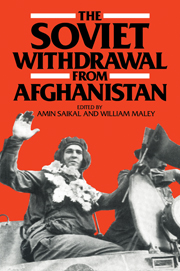Book contents
- Frontmatter
- Contents
- Preface
- 1 Introduction
- 2 The Geneva Accords of April 1988
- 3 Post-Withdrawal Afghanistan: Light at the End of the Tunnel
- 4 The Regional Politics of the Afghan Crisis
- 5 The Afghan Conflict and Soviet Domestic Politics
- 6 The Soviet Armed Forces and the Afghan War
- 7 Afghanistan and Soviet Alliances
- 8 Afghanistan and Sino-Soviet Relations
- 9 The Afghanistan 'Settlement' and the Future of World Politics
- 10 Conclusions: Management of the Afghan Crisis
- List of Contributors
- Index
3 - Post-Withdrawal Afghanistan: Light at the End of the Tunnel
Published online by Cambridge University Press: 09 November 2009
- Frontmatter
- Contents
- Preface
- 1 Introduction
- 2 The Geneva Accords of April 1988
- 3 Post-Withdrawal Afghanistan: Light at the End of the Tunnel
- 4 The Regional Politics of the Afghan Crisis
- 5 The Afghan Conflict and Soviet Domestic Politics
- 6 The Soviet Armed Forces and the Afghan War
- 7 Afghanistan and Soviet Alliances
- 8 Afghanistan and Sino-Soviet Relations
- 9 The Afghanistan 'Settlement' and the Future of World Politics
- 10 Conclusions: Management of the Afghan Crisis
- List of Contributors
- Index
Summary
With the Soviet troop withdrawal, we see the end of Afghanistan's major experience with European imperialism. Most of Africa and Asia were under European imperialist control for at least a hundred years—sometimes longer—but Afghanistan's experience was compressed into less than a decade in the late 20th century. Even then, the Soviets were able to exercise control over only a small portion of the total landscape.
This simply continues the patterns which evolved after the end of World War II. Any colony desiring freedom and supported by the population involved has gained independence. Even the Malaysian Insurgency is no exception, for although General Templer was able to defeat the insurgents, they were mainly Chinese Malays, who did not have the support of the non-Chinese peoples. After the suppression of the Communist insurgency, the Malays did gain independence from Britain. And the Afghan Mujahideen, with the overwhelming assistance of the population, succeeded in convincing the Soviets to leave their country. Never mind that the Soviets insisted they had fulfilled their ‘internationalist duty’, and that the Afghan army could take care of itself, and that the Republic of Afghanistan (led by the People's Democratic Party of Afghanistan—PDPA) could survive in some form, for all these premises fall down when analysed. By July 1988, even Soviet General K.M. Tsagolov, a former senior military officer in Afghanistan, publicly doubted the survivability of the Kabul regime. But how did this come about? What Afghan patterns helped determine the outcome of the war?
- Type
- Chapter
- Information
- The Soviet Withdrawal from Afghanistan , pp. 29 - 51Publisher: Cambridge University PressPrint publication year: 1989
- 9
- Cited by



